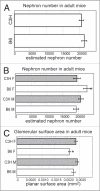The relationship between nephron number, kidney size and body weight in two inbred mouse strains
- PMID: 21197222
- PMCID: PMC2946052
- DOI: 10.4161/org.6.3.12125
The relationship between nephron number, kidney size and body weight in two inbred mouse strains
Abstract
While some reports in humans have shown that nephron number is positively correlated with height, body weight or kidney weight, other studies have not reproduced these findings. To understand the impact of genetic and environmental variation on these relationships, we examined whether nephron number correlates with body weight, kidney planar surface area, or kidney weight in two inbred mouse strains with contrasting kidney sizes but no overt renal pathology: C3H/HeJ and C57BL/6J. C3H/HeJ mice had smaller kidneys at birth and larger kidneys by adulthood, however there was no significant difference in nephron number between the two strains. We did observe a correlation between kidney size and body weight at birth and at adulthood for both strains. However, there was no relationship between nephron number and body weight or between nephron number and kidney size. From other studies, it appears that a greater than two-fold variation is required in each of these parameters in order to demonstrate these relationships, suggesting they are highly dependent on scale. Our results are therefore not surprising since there was a less than two-fold variation in each of the parameters examined. In summary, the relationship between nephron number and body or kidney size is most likely to be demonstrated when there is greater phenotypic variation either from genetic and/or environmental factors.
Keywords: B6; C3H; birth weight; hypertrophy; inbred; kidney size; mouse; nephron number.
Figures




References
-
- Hoy WE, Douglas-Denton RN, Hughson MD, Cass A, Johnson K, Bertram JF. A stereological study of glomerular number and volume: preliminary findings in a multiracial study of kidneys at autopsy. Kidney Int Suppl. 2003. pp. 31–37. - PubMed
-
- Hughson M, Farris AB, 3rd, Douglas-Denton R, Hoy WE, Bertram JF. Glomerular number and size in autopsy kidneys: the relationship to birth weight. Kidney Int. 2003;63:2113–2122. - PubMed
-
- Nyengaard JR, Bendtsen TF. Glomerular number and size in relation to age, kidney weight and body surface in normal man. Anat Rec. 1992;232:194–201. - PubMed
-
- Hinchliffe SA, Sargent PH, Howard CV, Chan YF, van Velzen D. Human intrauterine renal growth expressed in absolute number of glomeruli assessed by the disector method and Cavalieri principle. Lab Invest. 1991;64:777–784. - PubMed
-
- Merlet-Benichou C, Gilbert T, Vilar J, Moreau E, Freund N, Lelievre-Pegorier M. Nephron number: variability is the rule. Causes and consequences. Lab Invest. 1999;79:515–527. - PubMed
Publication types
MeSH terms
LinkOut - more resources
Full Text Sources
Medical
Molecular Biology Databases
